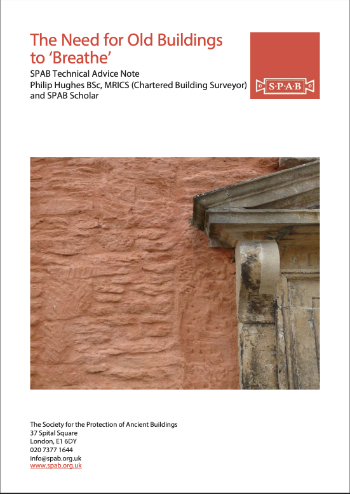SPAB Technical Note. The Need for Old Buildings to 'Breathe'
The Need for Old Buildings to ‘Breathe’ is the title of a Society for the Protection of Ancient Buildings (SPAB) Technical Advice Note and was written by Philip Hughes BSc, MRICS (Chartered Building Surveyor) and SPAB Scholar.
This document gives an excellent explanation of the differences between historical construction methods and materials and modern methods and materials. It describes extremely well the concept of 'breathing' materials, in the context of traditional construction and how their characteristics help prolong the life of historical buildings. It further describes issues relating to the introduction modern or impervious materials in the context of historical buildings and the issues this can cause.
It describes different applications from external render and pointing to internal plaster and paints as well as the nuances and gradations in the breathability of construction materials. It is not only a brief but invaluable resource for homeowners, designers and contractors dealing with historical buildings but also those looking to create modern buildings from natural or breathable materials.
Follow the link for further information about The Society for the Protection of Ancient Buildings (SPAB) and here to download the Technical Advice Note 'The Need for Old Buildings to ‘Breathe’'.
[edit] Related articles on Designing Buildings
- Conservation officer.
- Conservation.
- Defects in stonework.
- Dry hydrate lime mortar.
- Finding stone to conserve historic buildings.
- Hemp lime construction: A guide to building with hemp lime composites.
- High lime low alkali glass.
- Hot-mixed mortars: the new lime revival.
- Hydraulic lime.
- Hydrated lime.
- IHBC articles.
- Lime concrete.
- Lime mortar.
- Lime plaster.
- Lime putty mortar.
- Lime run-off.
- Masonry.
- Mortar.
- Mortar analysis for specifiers.
- Non hydraulic lime.
- Portland cement.
- Putty lime.
- Society for the Protection of Ancient Buildings.
- Soda-lime glass.
- Sourcing stone to repair Exeter Cathedral.
- The Institute of Historic Building Conservation.
- The use of lime mortar in building conservation.
- Types of mortar.
Featured articles and news
RTPI leader to become new CIOB Chief Executive Officer
Dr Victoria Hills MRTPI, FICE to take over after Caroline Gumble’s departure.
Social and affordable housing, a long term plan for delivery
The “Delivering a Decade of Renewal for Social and Affordable Housing” strategy sets out future path.
A change to adoptive architecture
Effects of global weather warming on architectural detailing, material choice and human interaction.
The proposed publicly owned and backed subsidiary of Homes England, to facilitate new homes.
How big is the problem and what can we do to mitigate the effects?
Overheating guidance and tools for building designers
A number of cool guides to help with the heat.
The UK's Modern Industrial Strategy: A 10 year plan
Previous consultation criticism, current key elements and general support with some persisting reservations.
Building Safety Regulator reforms
New roles, new staff and a new fast track service pave the way for a single construction regulator.
Architectural Technologist CPDs and Communications
CIAT CPD… and how you can do it!
Cooling centres and cool spaces
Managing extreme heat in cities by directing the public to places for heat stress relief and water sources.
Winter gardens: A brief history and warm variations
Extending the season with glass in different forms and terms.
Restoring Great Yarmouth's Winter Gardens
Transforming one of the least sustainable constructions imaginable.
Construction Skills Mission Board launch sector drive
Newly formed government and industry collaboration set strategy for recruiting an additional 100,000 construction workers a year.
New Architects Code comes into effect in September 2025
ARB Architects Code of Conduct and Practice available with ongoing consultation regarding guidance.
Welsh Skills Body (Medr) launches ambitious plan
The new skills body brings together funding and regulation of tertiary education and research for the devolved nation.
Paul Gandy FCIOB announced as next CIOB President
Former Tilbury Douglas CEO takes helm.
UK Infrastructure: A 10 Year Strategy. In brief with reactions
With the National Infrastructure and Service Transformation Authority (NISTA).























